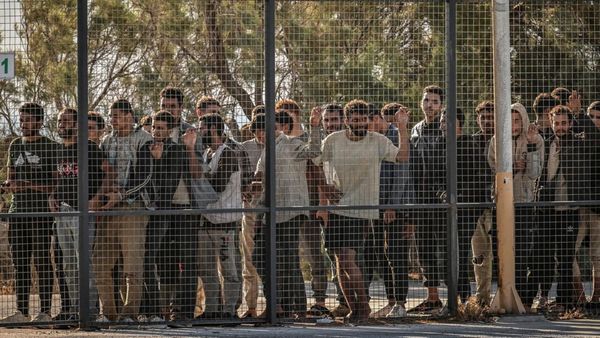
Ukrainian saboteurs coordinated by Kyiv’s military intelligence services are said to have carried out drone attacks on airfields deep inside Russia – one of which appears to have destroyed a supersonic Russian bomber.
It is one of a number of recent assaults on Russia and its military hardware, as well as drone attacks on Moscow. The latest such attack on the capital came overnight into Tuesday.
Responding to the attack on the Russian airfields, British military intelligence said that the weekend attack is highly likely to have destroyed a nuclear-capable Tu-22M3 supersonic long-range bomber. Kyiv says Russia has used the Tu-22M3 to bomb targets across Ukraine with conventional munitions. Western military experts believe Russia has around 60 of the aircrafts.
The destruction of the plane, which can be fitted with conventional or nuclear warheads, underscores the vulnerability to drone attacks of Russia’s fleet of ageing but lethal long-range bombers that are a major part of Moscow’s war effort.
Satellite images from Planet Labs PBC showed what appeared to be 10 long-range bombers parked on the apron of the Soltsy air base, about 400 miles from the border with Ukraine, on Wednesday 16 August. By Monday, two days after the attack, all those bombers had left the air base. A large black spot was visible on one of the aprons where one of the bombers had been parked. The attack appeared to prompt Russia to relocate other planes of the same type from the airfield to alternative bases further from Ukraine.
Russia's Defence Ministry said the attack on Saturday on one of its military airfields in the Novgorod region had been carried out by a Ukrainian drone and that one plane had been damaged. It gave no more details.
A satellite image of the Soltsy airfield, showing a black mark where one of the jets had been parked— (Planet Labs PBC via AP)
In a daily update on Ukraine, British military intelligence said “a Tu-22M3 BACKFIRE medium bomber of Russia’s Long Range Aviation (LRA) was highly likely destroyed at Soltsy-2 Airbase in Novgorod Oblast, 650km (403 miles) away from Ukraine’s border”.
“This is at least the third successful attack on LRA airfields, again raising questions about Russia’s ability to protect strategic locations deep inside the country,” it said.
Ukraine rarely claims such attacks, even if officials are not against pointing them out, but the Ukrainska Pravda newspaper and Ukraine's NV news outlet reported groups of saboteurs were behind the strikes. They attributed two attacks to the saboteurs: the one on Soltsy air base and one on Monday against the Shaikovka air base in the southwestern Kaluga region that is about 180 miles (300km) northeast of the Ukrainian border. Russia's Defense Ministry didn't comment on the reported attack on Shaikovka, but Russian media did.
Ukraine has repeatedly sought to take the war into the heart of Russia this year via drone attacks. It has increasingly targeted Moscow’s military assets behind the front lines in eastern and southern Ukraine.
Ukrainian military intelligence spokesman Andriy Yusov told the Ukrainian LIGA.net news outlet on Monday that at least one Russian warplane was damaged in the attack on Shaikovka. He said it was carried out by people who worked in close coordination with Ukrainian military intelligence but gave no further details.
As for the drone attacks on Moscow – which have increased in recent weeks – Russia’s Defence Ministry claimed a number were shot out of the sky on Tuesday, but falling wreckage of one drone shattered an apartment building’s windows and damaged vehicles in Moscow’s western suburbs. Flights at several Moscow airports were temporarily suspended Tuesday as a security precaution amid the attacks, authorities said.
A damaged residential building following a drone attack in the Moscow region on Tuesday— (AFP via Getty Images)
Meanwhile, Ukraine’s deputy defence minister, Hanna Maliar, said that the country’s forces have made progress in its counteroffensive to retake land occupied by Russia during the invasion ordered by President Vladimir Putin – and so proving Kyiv can push back a better-armed and numerically superior enemy.
Ukrainian troops have faced vast Russian minefields and trenches in the counteroffensive launched in early June, But Ms Maliar brushed aside any suggestion that Kyiv’s progress was too slow. “It's incorrect to measure this advance by metres or kilometres,” Ms Maliar told Reuters. “What’s important is the very fact that despite everything, we’re moving forward even though we have fewer people and fewer weapons.”
Ms Maliar highlighted the situation in eastern Ukraine, where she said Russian forces – who also enjoy air superiority – can fire 400,000-500,000 artillery shells each week or around 10 times more than Ukraine.
Earlier on Tuesday, she said Ukrainian troops had gained a foothold in the southeastern village of Robotyne on the road to Tokmak, an occupied rail hub whose recapture would be a milestone in Kyiv’s southward drive to reach the Sea of Azov. The next major settlement is the big regional city of Melitopol.
Germany’s foreign minister said on Tuesday Ukraine needed more help penetrating Russian minefields and that Berlin was discussing with its partners how to fulfil Kyiv’s requests for more equipment.
Reuters and Associated Press contributed to this report







